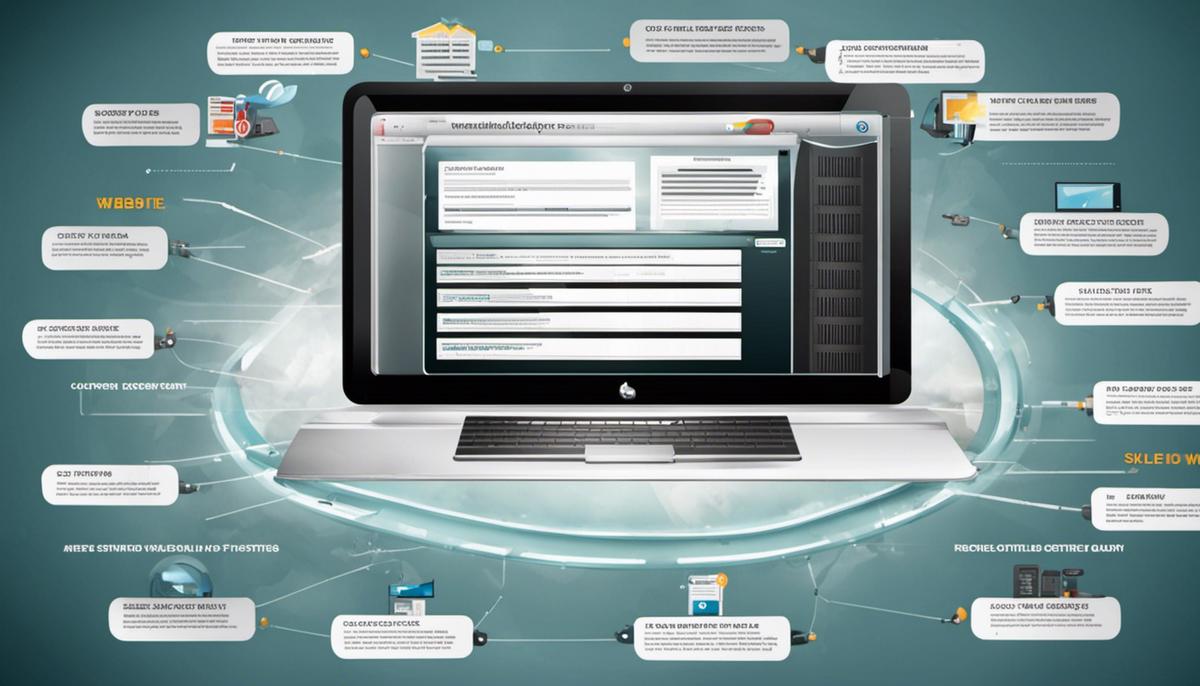BetterYouJourney.com is a participant in the Amazon Services LLC Some of the links in our posts are affiliate links. Click here to see full Disclosure.
In the rapidly advancing digital age, a robust online presence is essential for both individuals and businesses alike. A foundational component of this presence is a well-designed, fully functional website. Building and hosting a website might initially appear daunting, full of jargon and technicalities, however, with a thorough understanding of the process, it’s entirely manageable. Within this text, we delve into the essentials of website hosting, initiating with the basics such as understanding various types of web hosting services and domain name registration. Then, we progress to setting up your own hosting account, while highlighting the importance of key elements including bandwidth and uptime. Concurrently, we cover the all-important aspects of website design and its deployment, guiding you through selecting suitable web design tools, creating your website, and finally, publishing it on your host server to be accessible worldwide. Lastly, we explore routine website maintenance, troubleshooting techniques, and steps to ensure maximum website security.
Understand the Basics of Website Hosting
Understanding the Basics of Website Hosting
Web hosting is an online service that offers you the tools needed to get your website or web application on the internet. There are a vast array of hosting services available and the type you choose depends on what you want from your website.
Types of Web Hosting Services
- Shared Hosting: This is a basic type of hosting that’s suitable for people who are just starting out or have basic websites. Here, your website is stored on the same server as many other websites. While affordable, the downside is that you share resources, like RAM and CPU with the other websites.
- Virtual Private Server (VPS) Hosting: VPS is one step above shared hosting. You still share a server with other websites, but you have your own dedicated portion of that server’s resources. This gives you more control and capacity to handle larger amounts of traffic and complex sites.
- Dedicated Hosting: This hosting model provides independent servers for each client. As such, it offers the most control over your web server but is also more expensive. This would suit high-traffic websites and web apps.
- Cloud Hosting: Here, your website is hosted across a network of connected virtual and physical cloud servers. This allows for great scalability as you only pay for the resources you use.
Domain Name Registration
Domain name registration is the process of leasing a specific URL (like www.yourbusiness.com) for a period of time. When you register a domain name, you gain the right to use that name for your website for as long as you keep paying the yearly fee.
Registering a domain name involves choosing a registrar, searching for an available domain, and then purchasing it. Once that’s done, the domain name is yours to use.
When you register a domain, you’ll also need to route it to your web hosting service. This is accomplished by changing your domain’s DNS settings, usually under the guidance of your hosting company.
Understanding Web Hosting Terminologies
- Bandwidth: This refers to the amount of data that can be transferred between your website and its users in a given time period. The higher the bandwidth, the faster your website loads for your users.
- Uptime: Uptime measures the amount of time that a server is operational. High uptime percentages (like 99.9%) are a sign of a reliable, functioning server.
- Disk Space: The amount of storage provided by your hosting service to store your website’s files, images, video, and database.
- FTP (File Transfer Protocol): FTP is how you transfer your website files from your computer to your web hosting account.
Knowing these terms and understanding your hosting options will help you to make an informed decision when choosing a hosting service.

Setting Up a Hosting Account
Choosing a Hosting Provider
Selecting a hosting provider is the first crucial step when setting up a website. An optimal hosting provider provides stable and speedy services, high uptime guarantees, secure servers, and robust customer support according to your needs and budget. Common reliable hosting providers to consider include Bluehost, SiteGround, Dreamhost, A2 Hosting, and HostGator. Make sure to read reviews and compare their features before making a decision.
Creating a Hosting Account
After selecting your provider, visit their website to create a new account. You’ll typically see a “sign-up” or “get started” button. Click that, and follow the prompts to choose your hosting plan. Enter essential personal information such as your email address, billing address, and credit card details. Ensure to create a strong password for your account for security reasons.
Registering a Domain Name
Next, you will need to register a domain name. This will be your website’s address on the internet. Some hosting providers offer free domain names for one year as part of their hosting package. Meanwhile, others may charge an additional fee. Keep the domain name unique, short, easy to spell, and relevant to your website content.
Setting Up Email Accounts
The next step is setting up email accounts for your website. Most hosting providers allow you to create branded email addresses (for example, yourname@yourwebsite.com). Navigate to your hosting provider’s control panel typically labeled as ‘cPanel’. Click the “Email Accounts” section and follow the prompts to create a new email account. Remember to create a strong password.
Installing Necessary Software
Depending on the type of website you plan to create, you may need to install certain software on your server. This includes a database like MySQL or PostgreSQL for storing website data, and support for a programming language like PHP, Ruby, or Python.
Go to your hosting control panel, look for a feature labeled Software or Software and Services, and click “Install”. Choose your desired software to install and follow the prompts.
Setting Up a Database
Setting up a database is typically necessary for dynamic websites. In the hosting control panel, find a section called ‘Databases’. Click on ‘MySQL Databases’ or ‘PostgreSQL Databases’, depending on what your website requires. Write a name for your new database and click ‘Create Database’.
Connecting Domain Name and Hosting
Now you need to ensure your domain name points to your hosting account. This process takes place through a system called DNS (Domain Name System). Usually, your hosting provider will ask you to point your domain name to their servers by configuring specific DNS settings. Follow the instructions provided by your hosting provider to link your domain name with your hosting account.
Your website is now hosted and set up!
Be ready to install a content management system like WordPress next to start developing your site. Remember to frequently update your website software and plugins for optimal performance. Also, regularly check the spam folders in your webmail to make sure legitimate emails are not getting marked as spam.

Website Design and Deployment
Understanding Website Design Basics
Website design is the process of planning, conceptualizing, and arranging content intended for the Internet. Web design goes beyond aesthetics to include the website’s functionality and user experience. There are many important elements to consider in your design, like color, layout, fonts, and images. A well-designed website ensures that your visitors can easily find the information they need and directs them to take a specific action, like buying a product.
Choosing a Web Design Tool or Software
There are various web design tools and software to choose from based on your specific needs and technical skill level. For beginners, website builders like Wix or Weebly provide user-friendly drag-and-drop interfaces that do not require coding knowledge. More advanced tools like WordPress offer more customizable features but may require basic coding knowledge. Adobe Dreamweaver is a high-level tool for experienced programmers and web designers.
Constructing the Website
Your website should have a clear purpose and meet the needs of your target audience. Organize your site in a way that it’s easy for visitors to navigate. A basic website may include the following sections: Home, About Us, Services or Products, and Contact Us. Ensure you have high-quality, optimized images and engaging content that can resonate with your audience. Remember, your site’s design should be responsive, meaning it automatically adjusts to fit different screen sizes.
Publishing the Site to Your Hosting Server
Once your website is ready and tested, the next step is to upload it to your hosting server. This process involves several steps:
- Purchase a hosting plan: There are many web hosting providers to choose from like Bluehost, SiteGround, or HostGator. Pick a plan that fits your specific needs.
- Connect your domain name: After buying a hosting plan, connect your domain to your hosting account. Most hosting providers will offer step-by-step instructions for this process.
- Upload your website files: Most hosting providers offer File Transfer Protocol (FTP) to upload your site files. Download an FTP client, then enter your FTP details (provided by your hosting company) to connect to your server. Select all your site’s files and upload them to your server.
- Test your website: After uploading your files, test your website to ensure everything is working correctly. Simply enter your website URL in a browser.
Making Your Website Live
Once everything is working correctly, your website is live and accessible on the Internet. This is a major step in widening your reach and establishing your online presence. Always make sure your website stays up-to-date with fresh content and regular maintenance, as it represents your brand or company on the digital platform.

Website Maintenance and Troubleshooting
Step-by-Step Website Hosting and Setup
Before you can start hosting and updating your website, you’ll need to choose a hosting provider. Some of the most popular options include GoDaddy, Bluehost, and Hostgator. After you’ve chosen your provider, pick a hosting plan that suits your needs.
To set up your website, you’ll first need to register a domain name, which is the address people will use to access your site online. Your hosting provider will have instructions for how to do this, usually offering a domain service where you can purchase and register your site’s name.
Once you’ve registered your domain, you’ll need to install your website platform, such as WordPress if included in your plan or any other you prefer.
Website Maintenance and Troubleshooting Basics
Performing regular website backups is imperative to prevent data loss. Most hosting providers offer automated backup services that run on a schedule, whether daily, weekly, or monthly. If this is not included in your plan, consider using a WordPress plugin like UpdraftPlus for the same.
Updating website content regularly keeps your site relevant. In WordPress, you can update content by clicking on “Posts” or “Pages” from the dashboard, selecting the content you want to change, and clicking “Update” once you’ve made your modifications.
For troubleshooting hosting-related issues, usually, a quick contact with your provider’s customer support should be able to help. However, you can try resolving common issues like a slow website by optimizing your images, using caching plugins, or reducing the number of plugins on your site.
Understanding Website Security Measures
Your website’s security should be a top priority. One simple measure is to make sure all your website software (like WordPress, plugins, or themes) is up-to-date, as updates often include fixes for known vulnerabilities.
Strong, unique passwords are also a must for all accounts related to your website, including your hosting account, WordPress login, and email accounts.
Consider installing security plugins like Wordfence or Sucuri Security on your website that can help protect it from common cyber threats.
An SSL (Secure Sockets Layer) certificate is also vital for website security, especially if you’re operating an e-commerce site or storing sensitive user data. SSL encrypts data that’s sent between your site and a user’s computer, making it harder for hackers to intercept.
Remember, while these steps can enhance your website’s security, no measure is foolproof. Regularly review and update your security measures to ensure the best possible protection.
Dealing with Hackers
Despite your best security measures, hackers may still manage to breach your website. If this happens, start by contacting your hosting provider. They should be able to help you take your site offline temporarily to prevent further damage and guide you through the steps of recovering your website.
You should also notify your users as soon as possible and recommend that they change their passwords if they have accounts on your site. To prevent future hacking, consider hiring a professional to perform a security audit and address any vulnerabilities.

In the realm of digital entrepreneurship, having the knowledge and ability to host and maintain your own website can prove to be an invaluable asset. As we discovered, understanding the basics of website hosting, setting up a hosting account, designing and deploying a site, and carrying out necessary website maintenance and troubleshooting are not as complex as they first appear. With these provided tools, insights, and step-by-step guides, one can set up, host, and maintain a fully functional, secure website. With your newly achieved understanding, it’s now time to dive into the digital world and establish your distinct and dynamic online presence. Remember, a remarkable website is a prime gateway to opportunities in this digital age.








